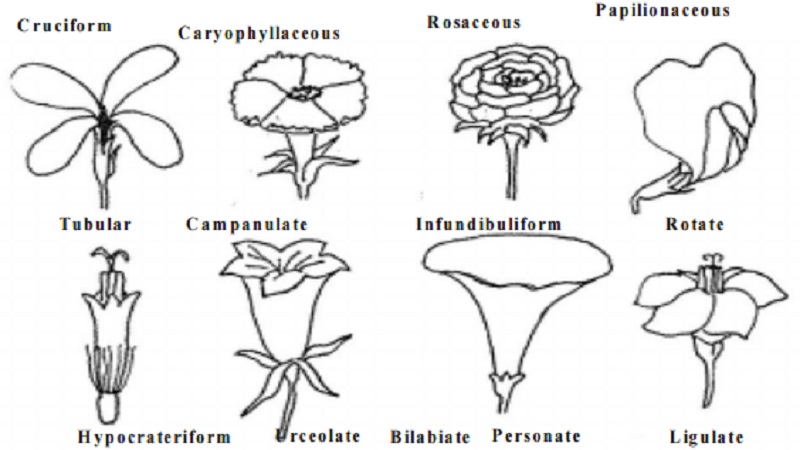Chapter: 11th 12th standard bio Biotany Plant Tree higher secondary school
Corolla : Shape of the petals in the corolla and Forms of Corolla

The corolla is the second accessory floral whorl consisting of petals.
The petals of the corolla are usually variously coloured and of delicate texture. They may be free (polypetalous) or united (gamopetalous). The primary function of the corolla is to attract insects for polinatioin and also serves to protect the essential organs.
Corolla
The corolla is the second accessory floral whorl consisting of petals.
The petals of the corolla are usually variously coloured and of delicate texture. They may be free (polypetalous) or united (gamopetalous). The primary function of the corolla is to attract insects for polinatioin and also serves to protect the essential organs.
Shape of the petals in the corolla
I.Clawed: The petal is narroe and slender at the base as a claw eg. Petals of Cruciferae.
II. Filmbriate: Petals fringed with hairy, teeth-like structure_eg. Dianthus
III. Laciniate: Petal divided into several long more or less equal segments.
IV. Spurred: Corola with a long hollow projection called spur eg. Delphinium majus.
Saccate: THe lower part of the corrolla tube gets dilated to form a sac-like structure eg. Antirhinum.
Forms of Corolla
A Polytalous and Regular
Cruciform: When the corolla consists of four clawed petals arranged at right angles to one another. eg. Brassica, Radish, etc.,
Caryphyllaceaus: when the corolla consists of five clawed petals with spreading limbs; claws and limbs are at right angles to one another. eg. Carroypyllaceae
Rasaceous: when the corolla consits of five spreading petals, without any claw eg. Wild Rose.
B Polyetalous and Irregular
Papillonaceous: whent he corolla consists of 5 petals, one large - the vexillum or standard petal which is posteior and outemost, two lateralsalae or wings at the sides and two partially fused structures - the keel or carina. eg. Pea, etc. (Fam. Fabaceae).
Orchidaceous: flowers with a peculiarity of combining calyx and corolla: One member, the petal in from of the stamen and stigma, differs from the rest in shape and in being nectarigerous: It is called a labellum. eg. Habenaria.
C Gamopetalous and Regular
Tubular: Corolla tube is more or less cylindrical. Eg. Disc florests of Helianthis
Companulate: when the corolla tube is inflated below and winded out at the top. It looks bell-shaped eg. Cucurbita maxima
Infundibuliform: corolla is funnel-shaped structure. eg. Datura
Rotate: When the corolla tube is short with spreading limbs at right angle to it. It looks like a wheel in shape eg. Solanum
Urceolate: un-shaped Corolla tube is inflated in the middle but narrow above and below, as inBryphyllum calycinum
D. Gamopetalous and Irregular
Bilabiate: Limb of the corolla is divided into two projecting lips eg. Ocimum
Personate:Corolla shows bilabiate condition with mouth closed by the projecting lip.et.Antirrhium
Ligulate:Strap-shaped. When the corolla tube is short and tubular at the base but flat above like a strap. eg. Ray florets of Asteraceae
Study Material, Lecturing Notes, Assignment, Reference, Wiki description explanation, brief detail
11th 12th standard bio Biotany Plant Tree higher secondary school : Corolla : Shape of the petals in the corolla and Forms of Corolla |
Related Topics
11th 12th standard bio Biotany Plant Tree higher secondary school